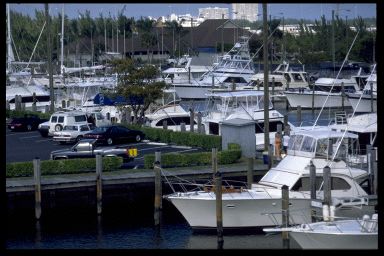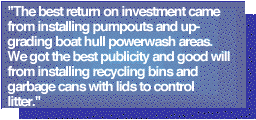
25. Westrec Marinas, Inc.
Clean Marina Image for World's Largest Chain
| Facilities: | 35 marinas owned and operated nationwide, 15 marinas managed for others, plus 10 other marinas considered Westrec Affiliates (in 1995) |
| Chain Office: | 16633 Ventura Blvd., 6th Floor, Encino, California 91436 |
| Telephone: | (818) 907-0400; fax: (818) 907-1104 |
| Interviewed: | William Anderson, President James Frye, Southeastern Area Vice President Gary Groenewold, Florida Regional Manager |
| Owned by: | Westrc Properties, Inc. |
| States: | Arizona, California, Florida, Georgia, Illinois, Maryland, Mississippi, New Jersey, New York, Texas, Washington D.C., Affiliates in: Alabama, California, Florida, Illinois, Louisiana, New Jersey, Texas, Virgin Islands, Washinton |
The nationwide marina chain
By all measures, Westrec Marinas is big. With a total storage capacity of 17,000 boats, and with facilities located in 12 states, the District of Columbia, and the Virgin Islands, plus Antigua, it is the world's largest full-service marina chain. Westrec's marinas are located on three coasts, a Great Lake, three man-made lakes, two major rivers, and several islands. Eleven are on fresh water and 25 on tidal salt water.
The chain started purchasing marinas in 1987. Now a totally independent corporation, Westrec in 1995 included 35 owned and operated marinas, 15 marinas managed under contract for others, and 10 affiliate marinas operated by others while receiving Westrec cooperative services. Seventy percent of the marinas are on privately owned land, whereas 30% are concessionaire marinas on government land. Half are totally owned by Westrec and half are operated for others. Westrec's investments total over $150 million.
The Westrec marinas have a combined total of 14,600 slips, 2,600 dry racks, and 3,000 moorings, which represent 40% of gross revenues. Holiday on Lake Lanier Marina is the largest with a capacity of 1,300 boats. Hall of Fame Marina, the smallest with a total of only 43 boat slips, caters to larger boats averaging 55 feet LOA, including 19 very large slips for megayachts up to 135 feet1.
Chain-wide about 20% of the boats are sailboats and 80% are powerboats. The boats kept in slips range from 16 feet LOA to 135 feet LOA, with the average around 32 feet LOA. Less than 10% of the slips are used by liveaboards. Transient slips are available at every facility and represent 5% of the gross income. The most common services in Westrec marinas, in addition to boat storage, are fuel dock, pumpouts, haulout by travel lift and/or forklift, boat repair services, restrooms/showers, convenience store, bait and tackle sales, laundry, and new boat sales. There are 20 waterfront restaurants in the chain, and all of the marinas have some type of food, drink, and ice service available.
Other services available in some marinas are outboard and houseboat rentals, boat charters, sailing school, RV park, campground, resort, swimming pool, hotel, scuba diving instruction, and office space rentals. It is estimated that Westrec marinas provide boating access to 505,000 people each season, not counting the additional public access provided by their parks, hotels, restaurants, and other services 2. To service all that boating public, Westrec had 1,000 full-time employees in 1995.
Management measures
Westrec marinas comply with all of the marina management measures, including marina flushing, water quality assessment, habitat assessment, shoreline stabilization, storm water runoff control, fueling station design, sewage facility, maintenance of sewage facilities, solid waste, fish waste, liquid materials, petroleum control, boat cleaning, and public education. Since marinas vary and many best management practices are site-specific, the number and kinds of BMPs used by Westrec do vary somewhat between facilities and states.
Environmental improvements
Environmental improvements "When I became president of Westrec Marinas in
1989, I had been working for the National Park Service. That made me predisposed
toward a clean environment as of critical importance to the public," explained
Bill Anderson. "While designing and planning urban waterfront parks, I learned
that there are ways to manage our resources, and to provide public use and enjoyment
of those resources without destroying them. I felt Westrec could and should balance
the environmental needs with our business needs, but I didn't know where to start.
In discussions with the International Marina Institute, we were given many suggestions
on how to get it done. As a result, in 1993, we hired a consultant3 to do a series
of studies of each marina covering issues such as compliance with the Americans with
Disabilities Act, nonpoint source pollution, and stormwater pollution prevention
plans. You have to make that kind of commitment for the long-term health of any marina,
and especially for a large chain like Westrec."
There were three basic reasons why Westrec was motivated to make environmental changes
in all its marinas.
- Economics - "We either had to clean up or be shut down in Southern Florida," said Jim Frye. "It proved to be less costly than we expected, and was a good investment which ultimately attracted more customers to our businesses."
- Create a clean marina company image and identity - "Our customers are very enthusiastic about our cleaner facilities, mowed green grass, and no litter. People really prefer to hang around a site that is not cluttered, but is really clean and neat," Gary Groenewold added, "and that's just the experience we at Westrec are trying to give everyone."
- Comply with the law and regulations - "One noticeable water quality improvement, which came from relocating and filtering boat power washing, has been the elimination of rings on boat hulls. So we know we are doing something right."
"The best return on investment came from installing pumpouts and upgrading boat
hull power-wash areas," said Groenewold. "We got the best publicity and
good will from installing recycling bins and garbage cans with lids to control litter."
"Westrec has spent over $200,000 to install pumpouts in all of its marinas.
Of the total cost, 10% went for engineering designs and permits, 50% to buy the equipment,
and 40% for construction and installation. Thus far we have received one Clean Vessel
Act grant totaling $8,000 to install one pumpout and have applied for grants to expand
several others. We were way ahead of the curve and installed pumpouts in our marinas
long before the grant program was available."
| Westrec's Harbour Towne Marina (see case study #14) in Dania, FL. |
 |
Most of Westrec's environmental capital improvement costs were funded from cash flow. Three facilities, for now, are adding a 2.5% environmental surcharge on every bill to gradually recoup costs of compliance and improvements.
"There are some economies of scale when you get a chain as big as we are," stated Frye. "The real cost of administering environmental changes is shared. When one of us becomes aware of an issue or problem, everyone becomes aware and we share information. We can purchase supplies, such as for spill containment, in quantity and get good discounts. Should one marina have a major spill, we can quickly move staff help and equipment in from other marinas. New practices can be tried out in a few places, then those that work are taken to the others. Westrec has the resources to get its arms around an issue and to make things happen."
"South Florida has one of the strictest best management practices (BMP) standards for marinas," explained Groenewold. "But we have decided to make Westrec's Florida BMP policies transparent and the same across the country. What differs are the state regulations, interpretation, and enforcement."
Some other examples:
- All leases for commercial space in Westrec Marinas had environmental language added in 1995 about the tenant's responsibility.
- Recycling is a system-wide philosophy at Westrec. "More often than not, we are taking practices from one state and using them in other states, exceeding what is required there," said Frye.
- Fuel tank remediation has included replacing most in-ground tanks with double-walled, fiberglass tanks with vapor sniffers and overspill protection. Double-walled hoses and piping have also been installed. Spill containment equipment is now available at all Westrec fuel docks, and some staff have been trained as first responders for oil spills.
- During all rehab and design improvements at Westrec marinas, green vegetated buffers-often lawns and plantings-are being added where possible for runoff control.
- Power wash pads for boat hulls have been moved away from the bulkhead and filters added to capture paint chips.
- In many facilities, the restrooms and showers were inadequate and have been or are being upgraded to in-crease customer use and satisfaction.
"Our employees are aware of Westrec's environmental policies. We discuss these
issues during regular staff meetings. It is part of our company culture to be environmentally
astute, to care for the environment, and to understand the need for clean water,"
said Anderson.
Several marinas do more and participate in regional clean water activities. For example,
Allatoona Landing Marina, in Georgia, hosts an annual Lake Lanier Cleanup. Harbour
Towne Marina (Florida) is one of three designated sites for the annual Intracoastal
Waterway Cleanup sponsored by the Marina Industry Association of South Florida (MIASF).
Hundreds of volunteers use their boats to pick up trash and litter. At Harbour Towne,
they usually fill up to six 30-cubic-yard dumpsters with trash. Westrec helps sponsor
the events, providing free soft drinks and hot dogs for participants.
"In 1995, we really began a market test at Harbour Towne Marina3
by instituting an environmental awareness contract. It worked so well we began using
it in other full-service marinas and expect to have it implemented in all Westrec
Marinas by 1996," Anderson said. "Our customers want us to be environmentally
clean. In 1995 our main office in California received about 5,000 survey cards from
customers throughout Westrec's chain. These cards come directly to the president,
and I read most of them personally. Nearly 20% include statements about environmental
issues."
The most common themes customers mention are:
- People want to be part of a marina that is doing something good for the environment.
- They like clean water.
- They are willing to pay for clean marinas.
And Westrec generally is a price leader in its market areas.
In the future, "Westrec expects to maintain its leadership role in marina environmental
awareness and regulatory compliance," Anderson said. "The bottom line is
that clean marinas are good for our business." 
Groenewold and Frye added, "Creating safe, enjoyable recreational experiences
can't be done if the water is dirty. An important part of going boating is to enjoy
the environment, to see pristine waterways free of styrofoam cups."
But they all agreed that "nationwide, the states need to be more consistent
in enforcing the marina and boating regulations. Enforcement must be applied to everyone-to
all marina facilities equally." But the Westrec marinas are not waiting-they
choose to lead the way.
Bill Anderson concluded, "It's the duty of all marina owners to preserve this
precious natural resource to the best of our ability. At the same time, we will be
preserving our business as well. Marinas and clean water go hand in hand."
1 -- See related case study 12, Hall of Fame Marina
2 -- Public access is estimated by multiplying the total number of boats used during the boating season (20,200 boats) by7 25, the average number of people who use a boat at least once a season.
3 -- Daniel S. Natchez and associates, Inc., Mamaroneck,
NY.
http://www.epa.gov/owow/NPS/marinas/ch25.html
This page last updated October 4, 1999


